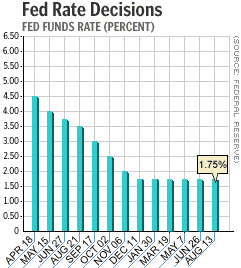NEW YORK (CNN/Money) -
The Federal Reserve said Wednesday it saw economic growth slowing across the United States in late summer, indicating policy makers still have reason to worry about the chance of further economic weakness.
The Fed's "Beige Book" report, a compilation of reports from the 12 Fed Districts, painted a mixed picture of the health of the world's largest economy. Strong sales of automobiles and homes contrasted with sluggish retail sales, while weakness in the labor market and in manufacturing continued.

Fed policy makers are scheduled to meet on Sept. 24 to discuss their target for short-term interest rates and will use the information in the Beige Book to help them decide whether or not to cut rates to fuel economic growth or to leave rates alone.
The Fed left rates alone in early August, but said it thought the risks to the economy were tilted toward more weakness than inflation. The Fed is charged with balancing economic growth and low inflation, and it manipulates interest rates to keep that balance.
Most economists doubt the Fed will cut rates again in September -- it made 11 cuts in 2001 to fight a recession that began in March 2001, but they also doubt the Fed will be raising rates to fight inflation anytime soon.
"This is somewhat consistent with the view at their last meeting that things were slow," said Joel Naroff, president and chief economist of Naroff Economic Advisors in Holland, Pa. "They're sending the word that they're still worried about weakness and that their bias is going to stay there."
Fed Chairman Alan Greenspan and other Fed officials have publicly expressed confidence that the economy will continue to grow, indicating they saw little need to cut rates right away.
Greenspan is scheduled to testify before the House Budget Committee Thursday at 10:00 a.m. ET and seems unlikely to offer much more insight about the Fed's next move.
A mixed economic picture
The report, named for the color of its cover and issued eight times a year, said retail sales were mixed, with some districts reporting slow clothing sales due to warm weather.
Not surprisingly, automobile sales were strong in almost all districts. Automakers have boosted sales this summer by offering aggressive incentives such as zero-percent financing.
Strength in the housing market continued in most of the country, with home sales and construction robust and demand for residential mortgages high.
But the rest of the report, which reflects information gathered between July 23 and Sept. 3, was mostly bad news. Manufacturing, travel and tourism activity were weak, and businesses took out few loans and hired few new workers.
While consumer spending fuels about two-thirds of the total U.S. economy, many economists think businesses will have to start spending again in order for the economy to truly recover. A slowdown in business spending following a boom in the late 1990s helped bring on the latest recession.

|

